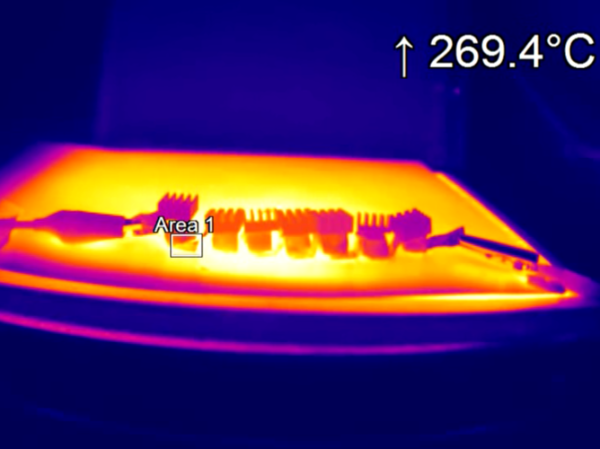Jun 14 2019
A new 3D printed thermoelectric device, which turns heat into electric power with an efficiency factor more than 50% higher than the earlier best for printed materials — and is inexpensive to produce in mass scale — has been produced by scientists at Swansea University’s SPECIFIC Innovation and Knowledge Centre.
 Thermal camera image: achieving record-breaking efficiency using new printed thermoelectric material. (Image credit: Swansea University)
Thermal camera image: achieving record-breaking efficiency using new printed thermoelectric material. (Image credit: Swansea University)
About one-sixth of all the energy consumed by industry in the UK presently ends up as waste heat, released into the air. Harnessing this to produce electricity could be a massive step forward in helping industry lower its energy bills and minimize its carbon footprint.
Thermoelectric materials convert variances in temperature into electric power, or vice versa. They are used in power plants, fridges, and even certain smart watches that are run using the heat of the body.
Earlier research has revealed that a material known as tin selenide (SnSe), a compound composed of tin (Sn) and selenium (Se), is very promising as a thermoelectric material. The issue is that the techniques used to make it require plenty of energy and are thus costly.
This is where the Swansea scientists’ research can be utilized. The method developed by them is potentially very low-cost for industry as it allows SnSe thermoelectric generators to be developed easily and quickly in bulk.
The researchers formulated SnSe into a type of ink which they could print to analyze its properties. The subsequent step was to create a type of 3D printing method to build a small thermoelectric generator using the ink.
The team’s experiments revealed that the material gave record scores for efficiency in performance, which is measured by the “Figure of Merit” (ZT).
The Swansea team’s element accomplished a ZT value (a measure of the thermoelectric generator's efficiency) of up to 1.7
The former best ZT score was 1.0 for a printed thermoelectric material.
This means an efficiency rate for converting heat into electricity for the Swansea researcher’s element was about 9.5%, compared with 4.5% for the earlier best.
The innovation could be of particular advantage to industries where high temperatures are common in the industrial process.
One example is steelmaking, which produces massive amounts of heat and requires substantial electrical power. Recycling the heat into power thus has the potential to improve energy efficiency considerably. Tata Steel may be supporting a PhD researcher on the team to investigate the industrial application of the technology.
The researchers are from SPECIFIC Innovation and Knowledge Centre, a Swansea University-led project which creates technologies for decreasing carbon emissions and shows how they can be applied to industry and buildings.
Turning waste heat into electrical power can boost energy efficiency significantly, cutting bills and reducing carbon emissions. Our findings show that printed thermoelectric materials using tin selenide are a very promising way forward. The device we developed is the best-performing printed thermoelectric material recorded to date, with the efficiency factor improved by over 50% compared to the previous record. It is also cheap to produce in bulk compared with established manufacturing methods. More work is needed, but already our work shows that this technique, combining efficiency and economy, could be very attractive to energy-intensive industries.
Dr Matt Carnie, Lead Researcher, Swansea University
The research paper was published in Advanced Energy Materials, one of the top academic journals in the field. It was sponsored through SPECIFIC Innovation and Knowledge Centre by the Engineering and Physical Sciences Research Council, Innovate UK, and the European Regional Development Fund, through the Welsh Government.